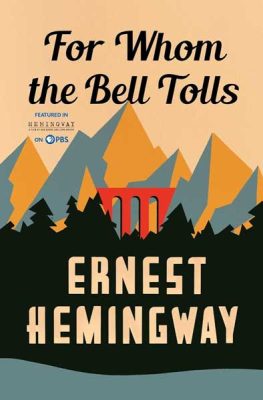Hemingway Classic a Bridge Too Far
Review An assessment or critique of a service, product, or creative endeavor such as art, literature or a performance.
By Michael Malone
 I figured it would make sense to read some Hemingway while visiting Key West during the February school break.
I figured it would make sense to read some Hemingway while visiting Key West during the February school break.
After all, Hemingway lived on Key West, with his wife Pauline, from the late 1920s until their divorce in 1940. It was there that he finished “A Farewell to Arms,” and wrote “For Whom the Bell Tolls,” “The Green Hills of Africa,” “Death in the Afternoon” and “To Have and Have Not.”
And so, I brought “For Whom the Bell Tolls.” The book is about Robert Jordan, an American fighting for the lefty Republicans in the Spanish Civil War. As the book begins, Robert Jordan, who is handy with dynamite, is tasked with blowing up a bridge in the woods outside Madrid.
I figured the bridge was but a subplot in Robert Jordan’s adventures in Spain. (Hemingway almost always refers to him, not as Robert or Jordan, but as Robert Jordan.) After 100 pages, I was surprised to see that the bridge was still standing, and Robert Jordan still plotting how to take it down.
After 200 pages, the same.
As it turns out, blowing up the bridge is the novel’s main plot.
“For Whom the Bell Tolls” is 471 pages, and it could’ve been half of that without losing an ounce of story. An awful lot of time passes without stuff happening.
One presumes Hemingway’s reputation, and ego, were so massive that an editor could merely fix a typo or two and not disturb his deathless prose.
The book takes place across four days, and it feels an awful lot longer. A subplot sees Robert fall in love with a young Spanish woman who shares the soldiers’ camp in the woods. The reader does not truly get to know Maria until the book is nearly finished, and she shares about the horrors she went through at the hands of the fascists. As she was tied up, she saw her parents killed, and then was raped.
Another subplot is that it snows in the forest in May. Hemingway gets way more mileage out of the snowfall than one might imagine.
A peculiar aspect of “For Whom the Bell Tolls” is that Hemingway would not write curses, but instead inserts the word “obscenity” in place of a curse. At one point, Maria says, “I obscenity in the milk of my shame.” It being a book about a bunch of soldiers out in the woods, there is a lot of cursing. More accurately, there’s a lot of the word “obscenity.” It is disorienting.
Every time I start a Hemingway novel, I think I will finally realize why the rest of the world thinks he’s an absolute master. Every time I finish a Hemingway novel, I feel the same way: Lame book with minimal plot. Author wrote about his experiences overseas, doing some masculine things, drinking an awful lot and falling in love. Where was the editor? And would the book get published today?
I’m not the only one who finds Hemingway’s books so-so. Some 292,000 raters on GoodReads gave “For Whom the Bell Tolls” a 3.98 out of 5. A good score, but not the mark of a literary superstar. “The Old Man and the Sea,” “The Sun Also Rises” and “A Farewell to Arms” all sit at 3.8.
Why do we love Hemingway so? My guess is that when his novels came out, between the late ‘20s and early ‘50s, American readers had not been to Italy or Spain or France. They had never seen a bullfight or caught a massive marlin or flirted with an English nurse. They had never consumed absinthe. Hemingway wrote of those places and pastimes, and it was exotic stuff for people who had never left their home state.
That’s not the case in 2024.
Never once did I read a sentence in “For Whom the Bell Tolls” and think to myself that’s some seriously good writing. The best I encountered was this bit, with Robert Jordan, known to his compadres as Ingles, out in the woods: “Robert Jordan saw them clearly over the blued steel barrel of the automatic rifle. He saw the faces of the men, the sabers hanging, the sweat-darkened flanks of the horses, and the cone-like shapes of the khaki capes, and the Navarrese slant of the khaki berets. The leader turned his horse directly toward the opening in the rocks where the gun was placed and Robert Jordan saw his young, sun- and wind-darkened face, his close-set eyes, hawk nose and the over-long wedge-shaped chin.”
Spoiler alert: The bridge finally comes down around page 435. I thought of Robert Jordan and his bridge plot as I drove across the Seven Mile Bridge en route to Key West.
I enjoyed the Hemingway house way more than I enjoyed the book I was reading. It was walkable from our hotel – most everything in Key West is walkable – and we got to see his home, his writing shed, his famous pool – the only one, at the time, for 100 miles – and his famous cats. Hemingway was given a cat with six toes by a ship’s captain, and Snow White went on to have several more “polydactyl” kittens. Hemingway named them after his famous friends: Marilyn Monroe. Errol Flynn. Edgar Allen Poe.
Today, 61 of them roam the grounds.
In short, skip “For Whom the Bell Tolls.” But check out Key West, and the Hemingway house – and the six-toed cats.
Journalist Michael Malone lives in Hawthorne with his wife and two children.

Examiner Media – Keeping you informed with professionally-reported local news, features, and sports coverage.
